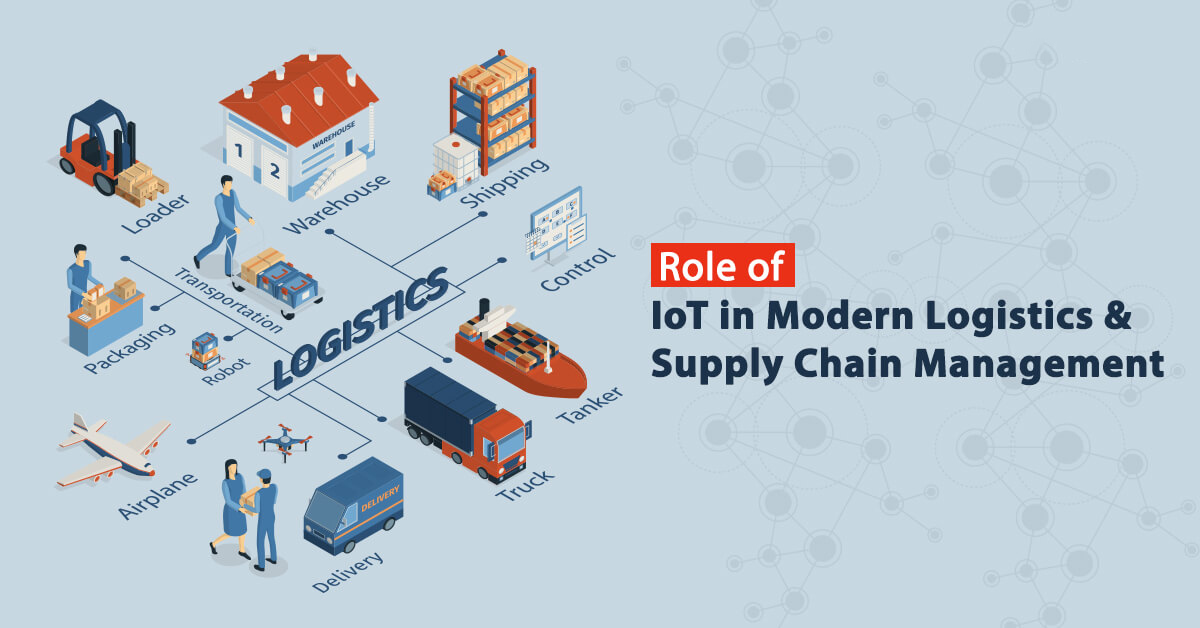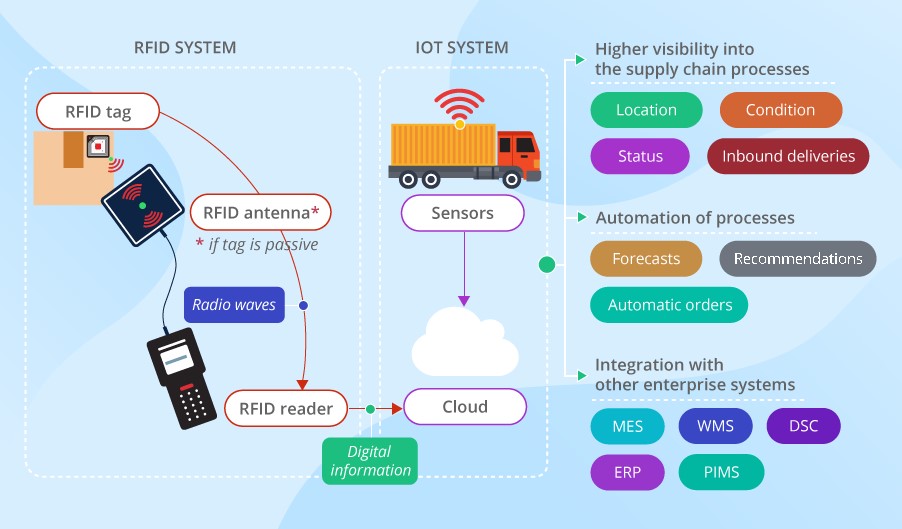How RFID & IoT Are Enhancing Supply Chain Visibility
Supply chain visibility is more important than ever in today’s fast-paced, technology-driven logistics industry. Companies need real-time insights into their inventory, shipments, and overall operations to improve efficiency, reduce costs, and meet rising customer expectations. Technologies like Radio Frequency Identification (RFID) and the Internet of Things (IoT) are transforming how supply chains operate, providing greater visibility, automation, and actionable intelligence. In this blog, we will explore how RFID and IoT are revolutionizing supply chain management and why businesses should embrace them.

Understanding RFID in Supply Chain Management
What is RFID?
Radio Frequency Identification (RFID) is a technology that uses electromagnetic fields to identify and track tags attached to objects. Unlike barcodes, RFID does not require direct line-of-sight scanning, making it faster and more efficient for tracking goods throughout the supply chain.
An RFID system consists of three main components:
- RFID Tags – Small devices embedded in products or packaging that store data.
- RFID Readers – Devices that scan and capture data from RFID tags.
- RFID Software – Systems that process and interpret the collected data for real-time tracking and analytics.
How RFID enhances Supply Chain Visibility
RFID technology significantly improves visibility in supply chain operations by enabling:
✅ Real-time Tracking: RFID tags on shipments, pallets, and individual products provide instant updates on their location and status, reducing the risk of lost or misplaced inventory.
✅ Improved Accuracy: Automated scanning eliminates human errors, reducing discrepancies in inventory records and ensuring accurate stock levels.
✅ Faster Processing: Unlike traditional barcode scanning, which requires individual item scanning, RFID readers can scan multiple items simultaneously, speeding up warehouse operations and order fulfillment.
✅ Enhanced Security: RFID helps prevent theft and fraud by monitoring unauthorized movement of goods and providing alerts in case of tampering or misplacement.
✅ Better Compliance and Reporting: Many industries require compliance with strict regulations. RFID simplifies tracking and documentation, ensuring businesses adhere to standards and audits.
The Role of IoT in Supply Chain Visibility
What is IoT?
The Internet of Things (IoT) refers to a network of interconnected smart devices that collect and exchange data over the internet. In supply chain management, IoT technology is used in the form of sensors, GPS trackers, and connected devices to monitor conditions such as location, temperature, humidity, and movement.
Key Applications of IoT in Logistics
IoT is driving innovation in various aspects of supply chain management, including:
🚛 Fleet Tracking & Route Optimization: GPS-enabled IoT devices help logistics companies track shipments in real time, optimize routes, and reduce fuel consumption. This leads to lower costs and improved delivery times.
📦 Smart Warehouses: IoT-powered sensors monitor inventory levels, automate stock replenishment, and improve order fulfillment accuracy. This helps reduce errors and enhance warehouse efficiency.
🌡 Cold Chain Monitoring: IoT sensors continuously monitor the temperature and humidity of perishable goods, such as food and pharmaceuticals, ensuring they remain within required conditions. Alerts are sent if conditions deviate from safe thresholds.
🔔 Predictive Maintenance: IoT devices track the health of warehouse equipment, vehicles, and machinery, predicting potential failures before they occur. This reduces downtime, enhances efficiency, and prevents costly breakdowns.
📊 Data Analytics & AI Integration: IoT-generated data provides valuable insights into operational inefficiencies, demand forecasting, and supply chain trends. AI-powered analytics can predict disruptions and optimize processes in real time.
The Synergy of RFID and IoT in Supply Chain Management
When used together, RFID and IoT create a more comprehensive, intelligent supply chain system.
- RFID provides identification and tracking – It enables businesses to track individual items, pallets, and shipments seamlessly.
- IoT adds real-time monitoring and analytics – It collects data on environmental conditions, location, and movement patterns to enhance decision-making.
- Cloud-based integration – Both technologies can be integrated with cloud platforms to provide a centralized dashboard for monitoring and managing logistics operations globally.
- Automation & Efficiency – Combined, RFID and IoT automate workflows, minimize human intervention, and improve operational efficiency.
Challenges in implementing RFID & IoT in Supply Chain
While these technologies offer significant advantages, businesses may face challenges in adopting them, such as:
❌ Initial Costs: Setting up RFID and IoT infrastructure requires investment in hardware, software, and integration with existing systems.
❌ Data Security & Privacy Concerns: With the increase in connected devices, companies need robust cybersecurity measures to prevent data breaches and unauthorized access.
❌ Integration Complexities: Businesses using legacy systems may find it challenging to integrate RFID and IoT without disrupting current operations.
❌ Scalability Issues: Expanding these solutions across multiple locations requires a well-planned strategy to ensure seamless functionality.
The Future of RFID & IoT in Supply Chain Management
As digital transformation accelerates, RFID and IoT adoption will continue to grow. The integration of artificial intelligence (AI), blockchain, and cloud computing will further enhance supply chain visibility by enabling:
🔹 AI-driven predictive analytics – Advanced forecasting to reduce inefficiencies and prevent disruptions.
🔹 Blockchain for secure tracking – Enhancing transparency and security in supply chain transactions.
🔹 5G connectivity – Faster and more reliable IoT communication for real-time data transfer.
By embracing RFID and IoT, businesses can achieve greater efficiency, cost savings, enhanced security, and improved customer satisfaction.

Final Thoughts: Embrace the Future of Supply Chain Visibility
RFID and IoT are no longer futuristic concepts but essential tools for modern supply chain management. Companies that adopt these technologies gain a competitive edge by improving inventory accuracy, streamlining operations, and responding swiftly to disruptions.
 Skip to main content
Skip to main content
